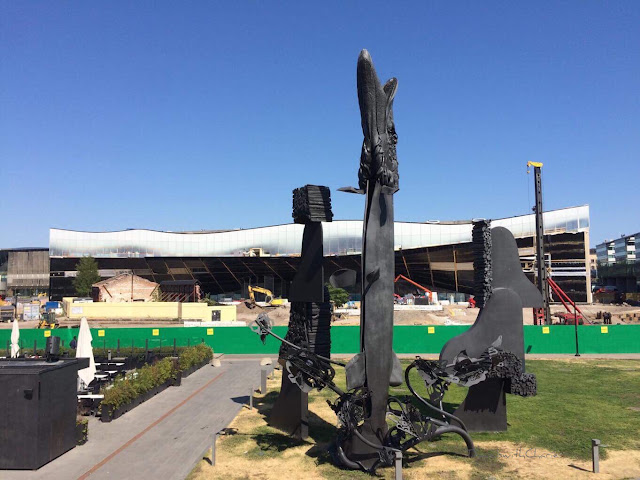 |
| Kamppi Chapel |
This beautiful wooden structure was designed by K2S Architects Ltd. The curved exterior wall is made from treated spruce wood planks and oiled alder planks line the interior walls. Light pours down the chapel from a skylight above the ceiling. The unadorned chapel is exactly the place to find peace and quiet.
"Silence is the only voice of our God." Herman Melville
 |
| Temppeliaukio Church |
There is a 3 euro entrance fee to the church.
 |
| Temppeliaukio Church |
 |
| Helsinki Cathedral |
 |
| Sibelius Monument |
"Music is, for me, like a beautiful mosaic which God has put together. He takes all the pieces in his hand, throws them into the world, and we have to recreate the picture from the pieces." Jean Sibelius
 |
| Kaivopuisto Park |
 |
| Market Square |
 |
| OODI Library and Laulupuut |
The three-part sculpture in the foreground (above image) is called Laulupuut (Song Trees) and is the work of Reijo Hukkanen whose inspiration for this ouevre comes from a Finnish poem, The Pike's Song. The tallest of the three sculptures bears the head of a pike.
 |
| The view from Kaivopuisto |
Where to stay:
Crowne Plaza Helsinki
Mannerheimintie 50
Tram 2, 4, 10
www.ihg.com
Crowne Plaza is right across from the City Park, Töölö Bay and Finlandia Hall. The rooms are spacious and the staff are friendly and efficient. There are several restaurants and grocery stores close to the hotel. The taxi fare from the central train station to the hotel is approximately 10 euros.
Holiday Inn Helsinki City Center
Elielinaukio 5
Next door to the Central Railway Station. Easy access to transportation, walking distance to shopping, restaurants, museums and Music Center.
www.ihg.com
How to get around:
From Vantaa Airport to City Center:
Take the train from the airport to the Central Railway Station in Helsinki. Signs at the airport lead to the train station. Buy the ticket from ticket machines near the tracks which accept credit or debit cards only. Station attendants can help you if you have any problems using the ticket machines. The fare was 5 euros in June 2018.
By tram:
Trams are handy to get around the city. Only credit or debit cards, the Helsinki card and a tram ticket which can be purchased from R-kioski, a kiosk that can be found all over town. I bought my tickets at R-kioski at the train station. The current tram fare is 2.90 euros (June 2018) and is good for 2 hours travel within the city.
Where to eat:
The best meal I had in Helsinki was at Market Square by the harbor. There are food stalls with tables and chairs for proper dining. I ordered their grilled salmon with mixed vegetables for less than 15 euros. There are several items on their menu or you can check out what they're cooking. Try also the Kauppatori or Food Hall at the harbor. There are restaurants and food counters to choose from inside the hall.
*****
Images by TravelswithCharie